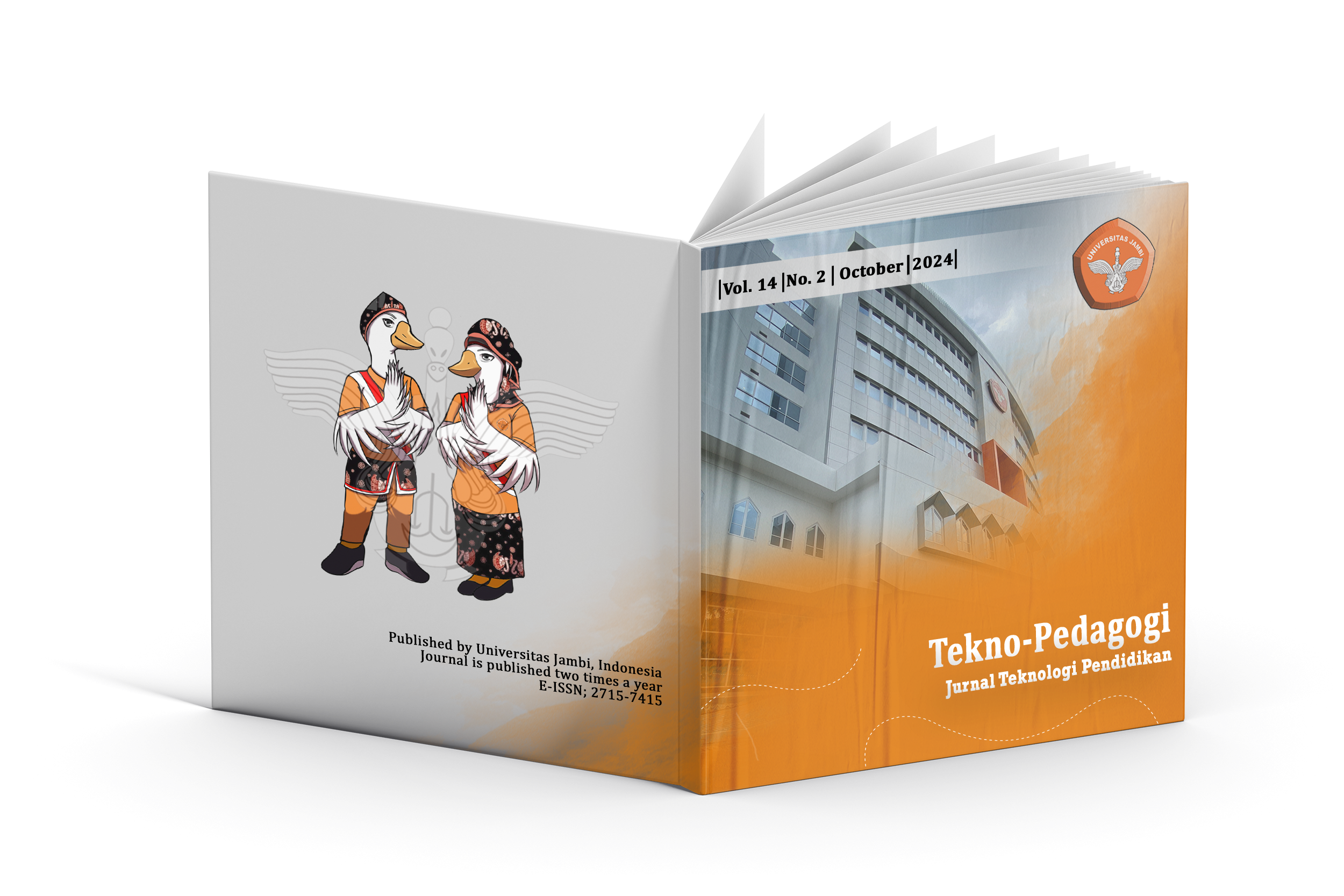Utilization of Learning Media Geography of High School in Sleman Regency
DOI:
https://doi.org/10.22437/teknopedagogi.v14i2.37435Keywords:
Media, Learning, GeographAbstract
This study aims to explore various aspects of learning media in geography at senior high schools in Sleman Regency, focusing on four key areas: the availability of media (including type, quantity, and condition), the utilization of media, the difficulties faced by teachers, and the efforts made to optimize media use. Utilizing a descriptive quantitative method, the research surveyed geography teachers and high school students in grades X, XI, and XII across 45 schools, comprising 17 public and 28 private institutions. A proportional random sampling technique selected 16 schools, with 16 teachers and 96 students chosen through purposive sampling. Data were collected via questionnaires, interviews, and observations, and analyzed using descriptive statistical techniques. Results revealed that the available learning media, primarily maps, atlases, and globes, were classified as insufficient in quantity, despite being in good condition. The utilization of media was in a favorable category, with a media variation of 68.75 percent. Student responses regarding media usage were high, and opportunities for engagement were also positive. However, teachers faced significant challenges, with 68.75 percent reporting difficulties related to limited media availability, manpower, costs, and time. Teachers' efforts to address these challenges were classified as moderate (87.50 percent), including organizing independent media, utilizing donations, and participating in training sessions and teacher meetings.
Downloads
References
Alam, G. M., Forhad, A. R., & Ismail, I. A. (2020). Can education as an ‘International Commodity’be the backbone or cane of a nation in the era of fourth industrial revolution?-A Comparative study. Technological Forecasting and Social Change, 159, 120184.
Ngoc, N. M., & Tien, N. H. (2023). Solutions for Development of High-Quality Human Resource in Binh Duong Industrial Province of Vietnam. International journal of business and globalisation, 4(1), 28-39.
Tyas, E. H., Sunarto, S., & Naibaho, L. (2020). Building superior human resources through character education. TEST Engineering & Management, 83, 11864-11873.
Pallathadka, H., Al-Hawary, S. I. S., Muda, I., Surahman, S. H., Al-Salami, A. A. A., & Nasimova, Z. (2023). The study of Islamic teachings in education: With an emphasis on behavioural gentleness. HTS Teologiese Studies/Theological Studies, 79(1).
Zaid, Z., Pettalongi, S. S., & Nurdin, N. (2022). Implementation of school-based management in improving the quality of State Islamic Junior High School. International Journal of Social Science and Human Research, 5(8), 3448-3455.
Arsul, A., Johanna, A., & Congzhao, H. (2021). The Principal's Business In Improving the Quality of Islamic Education (Case Study at SDIT AZ Jambi City). At-Tasyrih: jurnal pendidikan dan hukum Islam, 7(1), 1-16.
Kapoor, P. S., Balaji, M. S., & Jiang, Y. (2021). Effectiveness of sustainability communication on social media: role of message appeal and message source. International Journal of Contemporary Hospitality Management, 33(3), 949-972.
John, S. P., & De'Villiers, R. (2020). Elaboration of marketing communication through visual media: An empirical analysis. Journal of Retailing and Consumer Services, 54, 102052.
Winarto, W., Syahid, A., & Saguni, F. (2020). Effectiveness the use of audio visual media in teaching islamic religious education. International journal of contemporary Islamic education, 2(1), 81-107.
Bizami, N. A., Tasir, Z., & Kew, S. N. (2023). Innovative pedagogical principles and technological tools capabilities for immersive blended learning: a systematic literature review. Education and Information Technologies, 28(2), 1373-1425.
Sanulita, H., Hendriyanto, D., Lestari, N. C., Ramli, A., & Arifudin, O. (2024). Analysis Of The Effectiveness Of Audio Visual Learning Media Based On Macromedia Flash Usage On School Program Of Increasing Student Learning Motivation. Journal on Education, 6(2), 12641-12650.
Abdulrahaman, M. D., Faruk, N., Oloyede, A. A., Surajudeen-Bakinde, N. T., Olawoyin, L. A., Mejabi, O. V., ... & Azeez, A. L. (2020). Multimedia tools in the teaching and learning processes: A systematic review. Heliyon, 6(11).
Kartini, C. D., Chastanti, I., & Harahap, D. A. (2022). An analysis on obstacles to the science education process. Jurnal Penelitian Pendidikan IPA, 8(1), 309-315.
Ayu, M. (2020). Online learning: Leading e-learning at higher education. The Journal of English Literacy Education: The Teaching and Learning of English as a Foreign Language, 7(1), 47-54.
Qureshi, M. A., Khaskheli, A., Qureshi, J. A., Raza, S. A., & Yousufi, S. Q. (2023). Factors affecting students’ learning performance through collaborative learning and engagement. Interactive Learning Environments, 31(4), 2371-2391.
Sudarmo, S., Arifin, A., Pattiasina, P. J., Wirawan, V., & Aslan, A. (2021). The Future of Instruction Media in Indonesian Education: Systematic Review. Al-Ishlah: Jurnal Pendidikan, 13(2), 1302-1311.
Greenhow, C., Galvin, S. M., Brandon, D. L., & Askari, E. (2020). A decade of research on K–12 teaching and teacher learning with social media: Insights on the state of the field. Teachers College Record, 122(6), 1-72.
Adipat, S., Laksana, K., Busayanon, K., Asawasowan, A., & Adipat, B. (2021). Engaging students in the learning process with game-based learning: The fundamental concepts. International Journal of Technology in Education, 4(3), 542-552.
Ivey, G. (2023). Interpreting hidden meaning in qualitative research interview data: Opportunities and challenges. Qualitative Research in Psychology, 20(1), 21-51.
Downloads
Published
How to Cite
Issue
Section
License
Copyright (c) 2024 supriyati supriyati

This work is licensed under a Creative Commons Attribution 4.0 International License.





